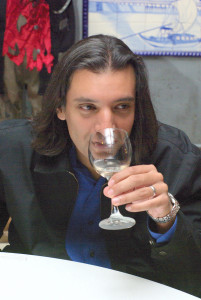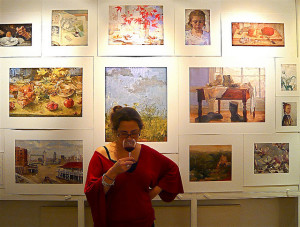Hello readers! I am currently on my maternity leave spending some quality time (and little sleep) with my brand new son! Enjoy this guest post from today’s featured author!
This is a guest post by Mo Bazzinni.
The flavor of a wine has six basic components (taste, texture, chemesthesis, aroma, sight & sound). All interact to create your very personal experience of wine. Although sight is the fastest and dominant sense (you believe what you see), eighty to ninety percent of the experience of wine comes from your sense of smell. Your brain interprets the signals sent from your olfactory bulb based on a combination of genetics, neural plasticity (training) and the current environment (noise, lights, mood, stuffy nose).

Photo courtesy Flickr user Adam Baker
Although taste determines acceptance or rejection of any wine, a trained palette is primarily a trained nose (olfactory system). The roof of our nasal cavity has an area containing millions of special neurons. Each neuron is covered with olfactory receptors that bind to odor molecules traveling through the air. Each neuron has a single type of odor receptor; it can only detect aromas that have the right molecular structure.
There are two basic types of olfaction. Sniffing wine outside your nose is called orthonasal olfaction. This activates the part of your brain that tells your taste buds to get ready to decide whether the wine is acceptable or not (i.e. too bitter, sour, sweet). If a wine is too bitter or sour to be acceptable to you (primarily based on genes inherited from your mother) the mid brain stem will react at a automatic level to prevent you from swallowing because the negative taste intensity passed the threshold of rejection.
Once wine is in your mouth and you find it acceptable (you don’t’ spit it out), the sense of smell is called retronasal (back of the mouth) olfaction. Retronasal olfaction activates the part of your brain concerned with memory and emotion but not speech. This is one key reason many people have a difficult time describing an aroma. One reason you may see a sommelier chew or gurgle their wine. This activity releases more of the aromatic compounds into your mouth making them easier to identify.
The average person can discern and describe around 1000 aromas (strawberry, cut grass, lemon) while an experienced sommelier can discern around 2,500 (anise, gooseberry, forest floor, violets). People who are trained to recognize odors (sommeliers or perfumers) are not necessarily any more genetically able to discern aromas. The long years and many hours of training rewired their neurology to identify the aromas at a much lower threshold of perception. Malcolm Gladwell’s 10,000-hour rule applied to wine. They are also much better at retrieving names of smells from memory than the vast majority of people.
A primary component of sommelier training consists of having a student taste wine with a more experienced sommelier to learn to identify and agree on a name for the aromas in wines. The names tend to be northern European vernacular. Many sommeliers can swirl wine then stick their nose in a glass, identify and many obscure aromas.
Olfaction has a number of complicating factors including adaptation and cross adaptation. An example of adaptation is cooking fish at home. If you go outside for a few minutes when you re-enter your home you notice the strong fish aroma you did not notice while cooking the fish. Cross adaptation occurs most commonly in a wine tasting room when a visitor is wearing strong perfume, or has been smoking a cigar or cigarette. The visitor’s sense of smell adapts to the aroma so the related aromas in the wine become invisible.
Genetic variation occurs in the sense of smell. A well-studied example is cilantro. Most people do not find cilantro offensive and enjoy the aroma of cilantro. About twenty five

Photo courtesy Flickr user Herry Lawford
percent of people dislike cilantro because it smells like soap to them. A number of people cannot discern any aroma from cilantro at all. Research indicates people with the AA genotype at rs7107418 are more likely to perceive a soapy taste in cilantro. It is unlikely cilantro is the only aromatic compound that has polar opposite impacts on flavor preference.
Cultural variation is a mitigating factor as well. All flavor descriptors of wine come from Northern Europe. So if you admonish a person in parts of Asia to identify the gooseberry or green apple notes in the wine, they will likely have no idea what you are talking about.
Before you begin wine tasting, make sure you are relaxed, in a cool but not cold room, preferably with subdued lighting and calming music. Being in a bad mood dulls our sense of smell for reasons unknown. You only have one brain to pay attention to all of your sensory inputs. The less distracted (loud music, bright lights, bad mood) the more relaxed and able to focus on the wine the more you will enjoy the full experience of the wine.
Techniques to optimize the experience the aroma of wine
- Put your nose into the wine glass and then breathe in thru your nose with a sniff, forcing the aromatic compounds into your nose.
- Wait thirty seconds or so to allow your sense of smell to recover from any adaptations that occurred.
- Now place the wine glass on a flat surface, swirl the wine in the glass keeping it on the flat surface, then move the glass under your nose and sniff as above.
- Wait thirty seconds or so, place the wine glass on a flat surface, cover the glass with the palm of your hand (or piece of paper), swirl the covered glass and move the glass still covered under your nose and uncover, then sniff. This allows the increased number and variety of aromatic compounds to enter your nose. Clean hands avoids cross adaptation.
- Clean the outside of your nose with a clean cloth, napkin or Kleenex. Unwrap one “Breathe Right” nasal strip; install it per package directions on your nose. Repeat steps one (1) through four (4) as described above.
Why use a Breathe Right Strip? Because the nasal cycle alternates the opening and closing of each nostril in rotation. Each nostril is also different in terms of diameter. Your two nostrils shift their workload back and forth during the day. Most (about 85%) of the aromas you inhale travel through just one nostril, while about 15% seeps in through the other nostril. The nasal cycle occurs in 85% of humans. By fully opening both nostrils at the same time you are better able to identify even hard to detect aromatic compounds (violets, anise), because you are exposing more of your olfactory bulb to more of the different VOCs. In a way turbo charging your olfactory system.
The autonomic nervous system creates the naturally occurring alternating congestion of the nasal passage (the nasal cycle). The nasal cycle varies, depending on the person and the situation. A cycle typically lasts from forty minutes to a couple of hours. When you use a Breathe Right Strip you are in essence turbo charging your olfactory system.
What’s the point of this? Your personal experience of wine is situationally dependent (lights, smells, sounds, genetics, neural plasticity, mood, venue). Don’t worry about what anyone thinks about your wine preference. Just enjoy the wine.

1 comment for “On Experiencing the Aromatics of Wine (Barolo and Breathe Rights): A Guest Post by Mo Bazzinni”